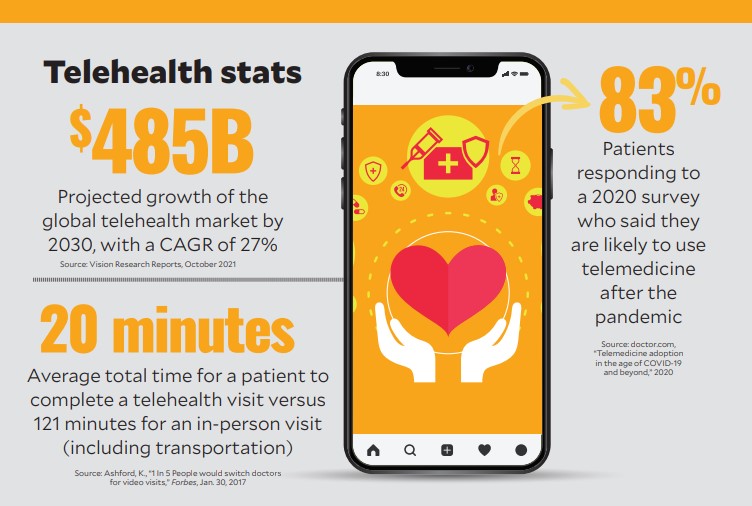Telehealth is primed for growth despite post-lockdown fade
When it comes to achieving true cost effectiveness of health, virtual healthcare will be key.
The core component of virtual healthcare, telehealth, has been an important tool for providing access to care throughout the pandemic. And although its use declined after exploding in the first year of the pandemic, the lessons of its utility and promise have not been lost. Many health systems have forged ahead with building and refining their virtual healthcare strategy, thereby helping to ensure telehealth will continue to play a pivotal role in the nation’s healthcare system.
These health systems are staunch believers in telehealth’s potential to improve the health of their patient populations and the overall effectiveness of our nation’s care delivery system. One such health system is Community Healthcare System, based in Munster, Indiana.
“The classic model of requiring patients to come to the doctor’s office or to the hospital for routine care is changing,” says Alan Kumar, MD, senior vice president of medical affairs and chief medical officer. “Healthcare today is increasingly driven by growth in outpatient and ambulatory services with a renewed focus on service and convenience. By using telehealth technology, we can be more adaptive to meeting patients where they are instead of in a more traditional healthcare setting.”

Regarding Community Healthcare System’s telehealth strategy, Kumar said, “We have taken a multichannel approach. Whether we reach patients through phone, video, our healthcare app or some other mode of telecommunication, our goal is to enhance patients’ connections to healthcare. Within the hospitals, we use this technology for areas such as telestroke and telemonitoring. We use it in outpatient and office settings through apps and digital connectivity with MyChart.”
This approach also has made the use of telehealth, as well as in-home devices and monitoring, commonplace among the health system’s patients.
“Strategically, we intend to continue exploring and adopting additional telehealth opportunities as they become more mainstream and viable,” said Kumar, who also anticipates increased acceptance by private and public payers.
Intermountain Healthcare in Salt Lake City is another health system leader in telehealth that recognizes its value for promoting cost effectiveness of health.
“We have always focused on increasing access and reducing the overall cost of care, and this has been a major driver of our telehealth strategy,” said Jim Sheets, regional COO, acute care, for Intermountain Healthcare. “What started as an initiative to create an on-demand, urgent care telehealth service — Intermountain’s Connect Care — evolved into a broad and comprehensive acute care and ambulatory telehealth service.”

Sheets underscored the benefits of telehealth in improving access in rural areas.
“Because we are a system serving an eight-state region, with numerous rural communities, we are keenly focused on keeping care local and extending difficult-to-access specialty services such as psychiatry, neurology and infectious disease care to rural communities,” he said.
Telehealth garners insurer support
The auspicious future of telehealth is evidenced by the support it has received from commercial insurers. Nationally, for example, the Blue Cross Blue Shield System has voiced strong support for telehealth services. BCBS has noted that such services will be of particular interest to millennials. Speaking in 2020 on its companies’ commitment to expand coverage and access to telehealth services after the pandemic, the insurer said, “For millennials, this shift could lead to a welcome, lasting change.”a BCBS also noted that a key takeaway from listening sessions with millennials and industry leaders was that “while millennials do not want to lose access to in-person care, they do need the flexibility and convenience of telehealth.” (For a discussion of the status of telehealth payment policy at the federal level, see the sidebar at the end of this article.)
Telehealth challenges and potential pitfalls
Technology poses one of the greatest challenges to an effective telehealth strategy, Kumar said.
“Integration is essential between the various versions of programs, platforms and operating systems,” he said. “The biggest hurdle is getting all those elements to work together seamlessly. you need a combination of compatibility, interoperability and ease-of-use. There are many wonderful apps out there, but we need to ensure that they feed back into our electronic medical record system and allow providers to easily access the information in one location as opposed to having to go to multiple platforms.”
Kumar also underscored the need for a strong technology team that can ensure patient needs are met in a way that aligns with the organization’s mission and delivery of care.
And then there are cost and timing challenges. “It takes a lot of strategic planning to make sure the technology is ready when needed. analytics play a large role in the decision-making process of resource investment. you need actionable analytics to avoid building out and presenting a platform before the patient population is ready.”
Sheets pointed to patient and physician adoption as early barriers, which Intermountain was able to overcome through quality service and access.
“Creating a relationship of trust with patients via technology is always a challenge, as well as emulating the in-person experience,” he said.
Payment is another ongoing challenge to telehealth, Sheets noted.
“While rates have improved, we still are challenged to obtain the payment levels that cover the costs of the providers,” he said.

Provider lessons learned
Perseverance and adaptability are two essential qualities for achieving success that the two health system leaders highlighted.
“You have to stick to your plan and keep your overall mission top of mind,” Sheets advised. “It can be easy to exit if you don’t realize immediate results.”
But he also underscored the importance of getting providers on board early. “Engage physicians early on in the planning, and help them see the benefit it provides to their practice and the patients,” Sheets said. “And then take the long view when it comes to adoption and financial return. There are many downstream benefits that you won’t immediately realize but are definitely there when it comes to telehealth.”
Kumar stressed the importance of adaptability. “You have to maintain a strategic vision at all times and adapt to the needs of the market,” he said. “The COVID pandemic is a perfect example of the flexibility you have to have when situations change — and in this case exceptionally quickly. It’s vital to keep the line of communication open with your medical staff providers so they are aware of the changes and have the support tools they need to adapt to new technology.”
Future outlook
Both Community Healthcare System and Intermountain Healthcare expect a positive future for telehealth.
“You will see increased adoption of these technologies and improved functionality and convenience for end users,” said Sheets. “There will still be some road bumps, but the overall outlook is very bright.”
Kumar concurred. “The future of telehealth will continue to evolve and become even more important in healthcare delivery over the next two decades,” he said. “How healthcare and the private and public payers grow with these changes is going to become more apparent over the next few years. Congress at a federal level will drive some changes, while leaders at the state level will drive others.”
Kumar also predicted innovation will help drive telehealth’s success.
“Innovation at individual health systems will play a role in improving healthcare delivery to patients,” he said. “It all comes down to patients desiring healthcare access in a convenient method that works with their lifestyles. We have an increasingly aging population starting to retire now, and they are much more tech savvy than their parents were. We have to be ready to meet those needs and provide the tools to improve their access to care.”
An imperative — and a calling
The larger message for providers comes back to how they will meet the nation’s supreme challenge of achieving cost effectiveness of health for all. By embracing telehealth as a valuable tool, provider organizations will not only help to advance this “just cause” but also reap benefits through improved patient access, engagement and outcomes. and as governmental and commercial payers increasingly promote virtual health through value-based payment arrangements, providers that lay the groundwork for a virtual healthcare strategy will have one more tool that will help them thrive financially in the rapidly evolving new world of consumer-focused healthcare.
Footnote
a. BCBS, “Opening new doors to care with telehealth,” Oct. 27, 2020.
Key points to consider in pursuing a virtual health strategy
It is important to keep in mind that telehealth is just one part of the industry’s larger adoption of virtual care options. Lucy Zielinski, managing partner of Lumina Health Partners in Chicago, sees this larger process as reflecting a profound shift in how healthcare services are delivered in the United States.

“I believe we will see a more personalized experience for patients, where care is integrated across the healthcare ecosystem,” Zielinski said. “We will see virtual care go beyond a provider visit and augmented with AI components and expansion of remote screening and wearable devices (as evidenced by the high investment activity in virtual health).”
Zielinski also sees virtual healthcare not as optional but as imperative.
“If providers are not incorporating or expanding their virtual care strategy, they will be squeezed out by competition — it is no longer just nice-to-have but a must-have” she said. “The way we experience healthcare today will be vastly different in a few years, where we will see consumerism greatly impact the delivery of primary care, and where providers focused on targeting care by condition will consider health equity components. And that’s a good thing.”
Zielinski offered four key considerations that healthcare organizations should keep in mind as they develop their telehealth strategy.
1 Make sure virtual healthcare is prominently addressed in value-based contracts. “As providers continue their value-based journey, virtual care must be a component to ensure successful performance under risk-based contracts focused on improving quality, reducing costs and enhancing patient satisfaction,” Zielinski said. The discussions of virtual healthcare’s role should emphasize its three key benefits, she said:
- Enables health equity initiatives by improving access
- Enables access to network providers
- Supports care management activities
2 Prepare for fierce competition, beyond primary care. Zielinski emphasized that consumers have an expectation for virtual services beyond primary care. “Consumer will access telehealth services for behavioral health, specialty care and home health,” she said. “And that will involve not only visits but also remote monitoring.”
3 Keep up with technology advances. “Operational workflows must support a fully integrated patient experience,” Zielinski said, noting that technology advances as well as tools, applications, and analytics will drive efficiency. “High-risk patients and can be identified and treated with early interventions via telehealth (including chronic care management and medication adherence). Patients appreciate the convenience and access – so it will only improve the patient experience.”
4 Tap into the benefits of virtual healthcare for improving provider retention and satisfaction. “As health systems contend with workforce issues and shortages, they should keep in mind that many providers, especially primary care providers, have experienced improvements in their work-life balance as a result of virtual healthcare, Zielinski said. “Their productivity also has improved, and they have seen improvements in patient care and outcomes, as well.
The PHE is ‘almost’ over, and the future looks auspicious for telehealth

While D.C. legislators and healthcare policy staff continue to watch for signs that the end of the public health emergency (PHE) could be in sight, healthcare providers struggle to keep their heads above water. Amid unpredictable ebbs and flows of hospital censuses, the shortage of clinical and administrative support staff and the emergence of a new consumer who has new and different expectations, providers continue to grapple with a new norm in healthcare — where telehealth stands ready to play a major role.
Setting aside the questions about whether the Medicare and Medicaid telehealth program expansions during the PHE will continue, it’s safe to say that the genie is out of the bottle. Consumers now have high expectations for the ease, convenience and assured safety of care — and that means having continued access to telehealth services.
The Medicare perspective
CMS’s rapid expansions of coverage of telehealth services and the delivery of telehealth services by many different types of providers have made large impacts on access to healthcare during the PHE, especially in areas where populations had long struggled with having access to care. These effects have not been lost on the agency. Notably, CMS reported that mental, behavioral and neurodevelopmental disorders accounted for the highest share of allowed charges for telehealth services (25%) in fee-for-service Medicare in 2020.

MedPAC weighs in
In its March report to Congress, the Medicare Payment Advisory Commission (MedPAC) wrote that “by mid-2021, nearly The PHE is ‘almost’ over, and the future looks auspicious for telehealth half of Medicare beneficiaries in the Commission’s annual telephone survey reported using telehealth at least once in the past year” and that “high shares of beneficiaries (89 percent) were satisfied with their telehealth visits.”
MedPAC recommended that CMS require healthcare providers to be more detailed in claim modifier usage, specifically for audio telehealth versus audio/video telehealth services. The commission was clear that more transparency is needed through billing and reporting for CMS and stakeholders to make sound analysis of usage, quality and outcomes pertaining to telehealth services.
Prognosis for ongoing federal support
The latest federal spending bill signed by President Biden in March extends Medicare’s telehealth provisions at least through December 2022, with most in the healthcare industry pushing congressional leaders for permanent allowances of telehealth service expansion. This subject also is quickly gaining bipartisan support along with the sharpened focus on mental health and substance use disorders.
Love it or hate it, the expansion of services covered under telehealth has made a significant impact on how the nation has accessed and delivered core healthcare services in the past two years. With the pandemic continuing to loom and consumer demands and travel costs on the rise, new players in the healthcare market are pushing their online platforms that promote convenient, high-quality, anytime access to primary care, mental health services and substance use disorder counseling, and a plethora of diagnostic services. In this environment, it seems certain that telehealth services will play a major role.
About the author
Shawn Stack is director, perspectives and analysis, HFMA, Washington, D.C.





